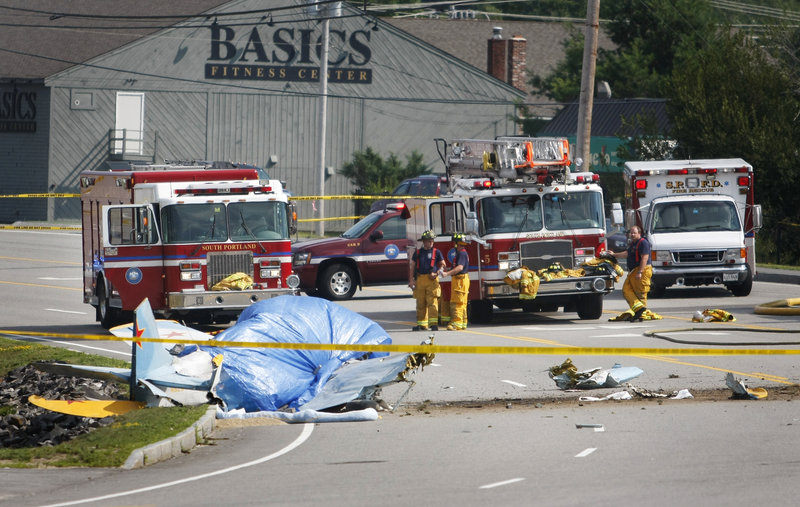Investigators looking for the cause of the July 17 plane crash in South Portland that killed two men are exploring the fuel system as a possible culprit, but they may never know for sure.
The National Transportation Safety Board posted its preliminary findings on the crash Thursday on its website.
The NTSB does not cite a cause, but does point out in the report’s final paragraph that investigators found what appears to be corrosion in the plane’s fuel pump and that they couldn’t get it to work.
The Yak-52, a Russian-made military and aerobatics trainer manufactured in 1985, crashed on Western Avenue shortly after takeoff, killing the pilot, Mark Haskell, 42, and a flight instructor, Thomas Casagrande, 66.
The report includes witness accounts of the crash and the moments preceding it, as well as mechanical issues that may have played a role. The NTSB’s final report could take several months to complete.
Board investigators plan to examine the fuel pump further, along with fuel lines and filters, the report said.
Investigators also found debris that prevented the engine’s exhaust valves from closing, which may have cut the plane’s power. The pump corrosion and the exhaust valve problem are consistent with a plane that has not been used for an extended period of time, experts said.
The NTSB report notes that Haskell, the plane’s owner, had not flown since Sept. 5, 2008 — almost two years before the crash — according to his logbook. The plane had been checked by a mechanic two weeks before the flight, the report said, but such annual condition inspections do not typically involve dismantling the engine or fuel system.
“This has a lot of red flags,” said Philip Greenspun, an aviation expert who reviewed the report at the request of The Portland Press Herald.
“One way to break an aircraft is to let it sit,” he said, noting that engine problems can develop within a few months. “If it had sat for months and months without being flown, this is a sure-fire recipe for mechanical problems.”
It is unlikely that the fuel was a problem. Aviation fuel is not like automobile fuel. It is not mixed with ethanol, which can damage aviation fuel systems and cause fuel to deteriorate.
Besides the high-performance plane’s lack of use, Greenspun said Haskell’s 416 hours of flight time was relatively short for someone who had his license for 23 years.
Haskell, an air traffic controller from Brunswick, was piloting the plane as part of his biennial flight review. Accompanying Haskell on the flight was Casagrande, a certified flight instructor approved to fly numerous aircraft and helicopters.
The pair had taken off without difficulty three times that Saturday. The fourth time, headed west on Runway 29 at the Portland International Jetport, an air traffic controller saw that the wings were rocking back and forth.
Haskell was asked if he needed to return to the airport. He responded that he did, and he began a slow left turn, the report said.
The controller asked if there were any problems and Haskell replied, “No, but it’s getting awfully hot in here,” the report said. Most planes like the Yak-52 don’t have air conditioning, and the temperature that day was 90 degrees.
The heat may have been the reason Haskell’s canopy was fully open and Casagrande’s was partially open. High temperatures also mean an aircraft engine has to work harder to get lift because the air is less dense.
Witnesses reported that the plane banked left, then nosed straight down. The plane crashed and slid 70 feet, spilling 20 gallons of fuel, the report said. A small fire in the engine compartment was extinguished by a local worker.
The plane was later moved off site for inspection.
The investigation involved the NTSB official in charge, three Federal Aviation Administration inspectors and two representatives of Coy Aircraft Sales Ltd., which delivered the aircraft to Haskell when he purchased it in 2001.
Investigators determined the flight controls were operable and that the landing gear and flaps were in the up position.
The NTSB investigator has said the propeller was not spinning when the plane hit the ground, although it is unclear when the engine stopped.
Pilots are trained not to try to return to the airport if the engine cuts out, Greenspun said. Planes often lack the altitude and speed to complete the change in direction, dubbed “the impossible turn,” if there is a mechanical problem.
The NTSB report does not indicate how high the plane was when it began turning back to the airport.
Greenspun said it is unusual for NTSB investigators to identify potential mechanical failures, so any that are noted are potentially important, he said. Still, the investigations often don’t yield a clear-cut explanation for a crash.
Many conclude a crash is the result of an unexplained loss of power and the pilot’s inability to respond to the circumstances, he said.
Staff Writer David Hench can be contacted at 791-6327 or at:
dhench@pressherald.com
Copy the Story Link
Send questions/comments to the editors.



Success. Please wait for the page to reload. If the page does not reload within 5 seconds, please refresh the page.
Enter your email and password to access comments.
Hi, to comment on stories you must . This profile is in addition to your subscription and website login.
Already have a commenting profile? .
Invalid username/password.
Please check your email to confirm and complete your registration.
Only subscribers are eligible to post comments. Please subscribe or login first for digital access. Here’s why.
Use the form below to reset your password. When you've submitted your account email, we will send an email with a reset code.